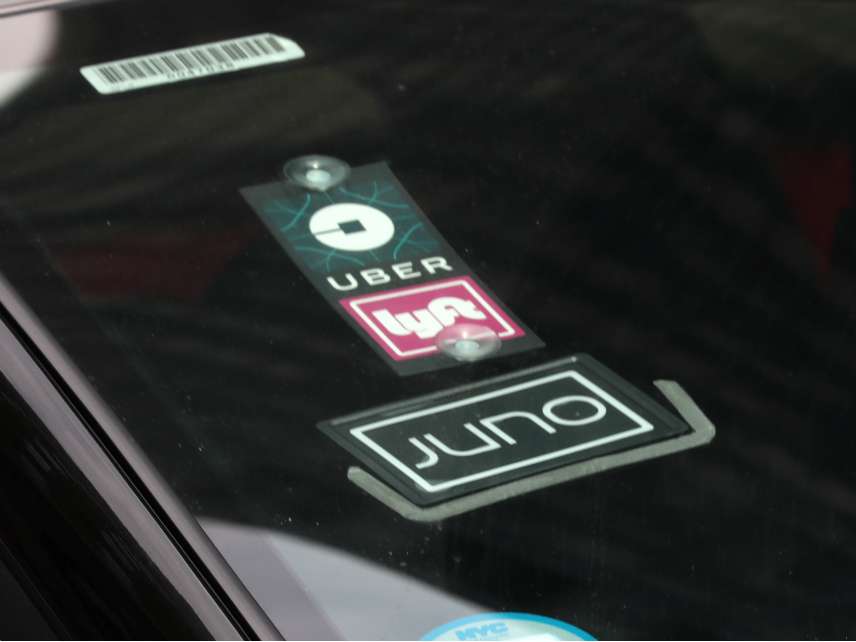New York City's Minimum Wage Law for Rideshare Drivers Might Actually Be Reducing Drivers' Pay
New court documents suggest that the city's rideshare regulations have backfired in a big way

New York City's new minimum pay rules for rideshare drivers were intended to boost driver income, but they may be having the exact opposite effect.
On Tuesday, rideshare company Juno—which is currently suing city regulators over the new pay rules—filed court documents showing that their bookings are down some 30 percent for the month of February (when the new pay rules went into effect) and that average hourly compensation has fallen by 17 percent.
"Costs have increased for riders, demand for Juno's services has decreased, and hourly earnings for Juno's drivers have fallen," reads a memorandum filed by Juno, which warns that these effects "will only get worse" so long as the rules remain in place.
The decline is particularly concerning, Juno CEO Ronen Ben David wrote in a separate court filing, because the company had been seeing business increase prior to the implementation of the new pay rules. Juno performs about 5 percent of rideshare rides in New York City, compared to about 20 percent for Lyft and 70 percent for Uber.
Lyft, which is also suing New York City regulators, reports that they, too, are seeing a decline in rides booked though their app, although it has not been as severe as the hit reported by Juno. Lyft estimates that the city's rideshare industry could see a $50 million decline in bookings in 2019.
In August of last year, the New York City Council passed a bill requiring the city's Taxi and Limousine Commission (TLC)—the regulator responsible for the rideshare industry and the target of Lyft and Juno's lawsuits—to come up with pay standards that would raise drivers' earnings to $17.22 an hour.
In December, the TLC did just that, issuing new driver pay rules built around a complicated formula that factors in an individual trip's time and length as well as a company's utilization rate (the amount of time drivers actually have a passenger in the car.)
In their lawsuits, Juno and Lyft object to the commission's rule on two grounds.
The first objection made by both companies is the way the TLC's driver pay formula employs the utilization rate. Without getting too in the weeds, the higher a company's utilization rate, the less it has to pay per-trip to its drivers. That advantages companies like Uber and Via, which both have higher utilization rates, by allowing them to pay drivers less for the exact same trip.
The Juno suit argues that companies with lower utilization rates will have to raise fares to cope with these higher costs, which scares away riders, further lowering their utilization rate and raising their per-trip costs, which requires more fare increases. The company says this vicious cycle will ultimately kill off smaller services.
Lyft also objects to the TLC's formula calculating pay on a per-trip basis, which the company argues both violates the city council law establishing pay standards, and creates distortions in the market.
A report from MIT Professor Catherine Tucker, filed as part of Lyft's lawsuit, argues that a rigid per-trip formula prevents companies from adjusting fares and driver pay to respond to changes in demand throughout the day.
Tucker's report also argues that the TLC's current formula rewards drivers for completing short, slow trips, as opposed to longer or faster rides—essentially creating an incentive for drivers to service riders in dense Manhattan at the expense of commuters in the city's outer boroughs. That incentive works against another of the city's goals, which is to reduce congestion in Manhattan. Starting in February, for-hire vehicles entering Manhattan have to pay a new fee designed to limit car trips on the island's gridlocked streets. Traditional cabs pay $2.50 per trip, while trips performed by rideshare companies are slapped with a $2.75 fee. Shared rides performed on UberPool or Lyft Line pay only a $.75 fee.
Disentangling the effects of the congestion surcharge and the fare hikes that followed the new minimum pay rules is difficult. Their combined effect is that rideshare trips are costing more, and people are taking fewer of them.
Thanks to perverse incentives contained in the TLC's pay rules, the decline in trips will likely not net out any improvements in congestion. As the market for rideshare rides shrinks, total driver compensation could start to fall as well. According to Juno's court filings, it already has.
Juno and Lyft's lawsuits are still ongoing. In February a judge issued a temporary restraining order against the TLC's new pay formula, but Lyft at least has chosen to continue to comply with the rules as its case works its way through the courts.
For now, it appears that if these new regulations "help" anyone, it will be Uber and the incumbent taxi industry and taxi medallion owners; many of whom have refinanced their medallions so many times that they are essentially underwater on an investment that is devalued by rideshare competition. There are already clear losers: passengers and smaller rideshare companies trying to earn their business.
Rent Free is a weekly newsletter from Christian Britschgi on urbanism and the fight for less regulation, more housing, more property rights, and more freedom in America's cities.


Show Comments (24)